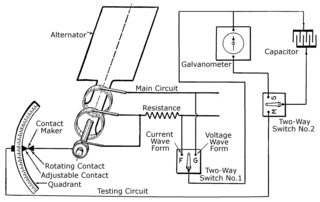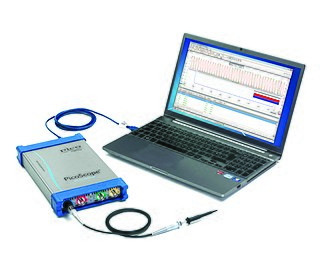A signal generator is one of a class of electronic devices that generates electrical signals with set properties of amplitude, frequency, and wave shape. These generated signals are used as a stimulus for electronic measurements, typically used in designing, testing, troubleshooting, and repairing electronic or electroacoustic devices, though it often has artistic uses as well.

Electronic test equipment is used to create signals and capture responses from electronic devices under test (DUTs). In this way, the proper operation of the DUT can be proven or faults in the device can be traced. Use of electronic test equipment is essential to any serious work on electronics systems.
This is an index of articles relating to electronics and electricity or natural electricity and things that run on electricity and things that use or conduct electricity.

A spectrum analyzer measures the magnitude of an input signal versus frequency within the full frequency range of the instrument. The primary use is to measure the power of the spectrum of known and unknown signals. The input signal that most common spectrum analyzers measure is electrical; however, spectral compositions of other signals, such as acoustic pressure waves and optical light waves, can be considered through the use of an appropriate transducer. Spectrum analyzers for other types of signals also exist, such as optical spectrum analyzers which use direct optical techniques such as a monochromator to make measurements.
Gamma-ray spectroscopy is the qualitative study of the energy spectra of gamma-ray sources, such as in the nuclear industry, geochemical investigation, and astrophysics. Gamma-ray spectrometry, on the other hand, is the method used to acquire a quantitative spectrum measurement.
Stanford Research Systems is a maker of general test and measurement instruments. The company was founded in 1980, is privately held, and is not affiliated with Stanford University.

An arbitrary waveform generator (AWG) is a piece of electronic test equipment used to generate electrical waveforms. These waveforms can be either repetitive or single-shot in which case some kind of triggering source is required. The resulting waveforms can be injected into a device under test and analyzed as they progress through it, confirming the proper operation of the device or pinpointing a fault in it.
A digital delay generator is a piece of electronic test equipment that provides precise delays for triggering, syncing, delaying, and gating events. These generators are used in many experiments, controls, and processes where electronic timing of a single event or multiple events to a standard timing reference is needed. The digital delay generator may initiate a sequence of events or be triggered by an event. What differentiates it from ordinary electronic timing is the synchronicity of its outputs to each other and the initiating event.

An oscilloscope is a type of electronic test instrument that graphically displays varying voltages of one or more signals as a function of time. Their main purpose is capturing information on electrical signals for debugging, analysis, or characterization. The displayed waveform can then be analyzed for properties such as amplitude, frequency, rise time, time interval, distortion, and others. Originally, calculation of these values required manually measuring the waveform against the scales built into the screen of the instrument. Modern digital instruments may calculate and display these properties directly.
A digital pattern generator is a piece of electronic test equipment or software used to generate digital electronic stimuli. Digital electronics stimuli are a specific kind of electrical waveform varying between two conventional voltages that correspond to two logic states. The main purpose of a digital pattern generator is to stimulate the inputs of a digital electronic device. For that reason, the voltage levels generated by a digital pattern generator are often compatible with digital electronics I/O standards – TTL, LVTTL, LVCMOS and LVDS, for instance.

The history of the oscilloscope was fundamental to science because an oscilloscope is a device for viewing waveform oscillations, as of electrical voltage or current, in order to measure frequency and other wave characteristics. This was important in developing electromagnetic theory. The first recordings of waveforms were with a galvanometer coupled to a mechanical drawing system dating from the second decade of the 19th century. The modern day digital oscilloscope is a consequence of multiple generations of development of the oscillograph, cathode-ray tubes, analog oscilloscopes, and digital electronics.

An audio analyzer is a test and measurement instrument used to objectively quantify the audio performance of electronic and electro-acoustical devices. Audio quality metrics cover a wide variety of parameters, including level, gain, noise, harmonic and intermodulation distortion, frequency response, relative phase of signals, interchannel crosstalk, and more. In addition, many manufacturers have requirements for behavior and connectivity of audio devices that require specific tests and confirmations.
Sodern is a French company based in Limeil-Brévannes, near Paris in Ile-de-France, specialized in space instrumentation, optics and neutron analyzers.

Pico Technology is a British manufacturer of high-precision PC-based oscilloscopes and automotive diagnostics equipment, founded in 1991. Their product range includes the PicoScope line of PC-based oscilloscopes, data loggers, automotive equipment, and most recently, handheld USB-based oscilloscopes. Since their inception in 1991, Pico Tech has been researching and developing PC-based oscilloscopes, when the market standard was analogue storage oscilloscopes. Pico Technology is one of two European scope manufacturers, and competes in the low to middle end of the instrumentation market.

PicoScope is computer software for real-time signal acquisition of Pico Technology oscilloscopes. PicoScope is supported on Microsoft Windows, Mac OS X, Debian and Ubuntu platforms. PicoScope is primarily used to view and analyze real-time signals from PicoScope oscilloscopes and data loggers. PicoScope software enables analysis using FFT, a spectrum analyser, voltage-based triggers, and the ability to save/load waveforms to disk. PicoScope is compatible with parallel port oscilloscopes and the newer USB oscilloscopes.

A radionuclide identification device is a small, lightweight, portable gamma-ray spectrometer used for the detection and identification of radioactive substances. These devices are available from many companies in various forms to provide hand-held gamma-ray radionuclide identification. Since these instruments are easily carried, they are suitable for first-line responders in key applications of Homeland Security, Environmental Monitoring and Radiological Mapping. These devices are also useful in medical and industrial applications as well as a number of unique applications such as geological surveys. In the past two decades RIIDs have addressed the growing demand for fast, accurate isotope identification. These light-weight instruments require room temperature detectors so they can be easily carried and perform meaningful measurements in various environments and locations.
Carl A. Vossberg, Jr., was an American electrical engineer, inventor, and entrepreneur in the electronic instrumentation industry. He is known for more than 30 technical patents in the area of refractometry, measurement, and control. Vossberg also founded Electron-Machine Corporation, the company responsible for the introduction of inline process refractometers as a measuring system for the pulp & paper, food, and chemical processing industries.

Switching Noise Jitter (SNJ) is the aggregation of variability of noise events in the time-domain on the supply bias of an electronic system, in particular with a voltage regulated supply bias incorporated with closed-loop (feedback) control, for instance, SMPS. SNJ is measurable using real-time spectral histogram analysis and expressed as a rate of occurrence in percentage. The existence of SNJ was firstly demonstrated and termed by TransSiP Inc in 2016 and 2017 at the Applied Power Electronics Conference (APEC), and reviewed with experts at Tektronix prior to be featured as a case study published by Tektronix. The discovery of SNJ was also featured in multiple articles published by Planet Analog magazine and EDN Network. Difficult to filter using conventional LC networks due to variability in both time and frequency domains, SNJ can introduce random errors in analog to digital conversion, affecting both data integrity and system performance in digital communications and location-based services









